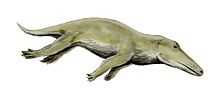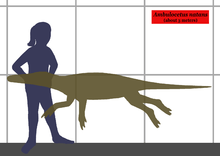Ambulocetus
| Ambulocetus Temporal range: Early Eocene, 50–48Ma | |
|---|---|
 | |
| Restoration. | |
| Scientific classification | |
| Kingdom: | Animalia |
| Phylum: | Chordata |
| Class: | Mammalia |
| Order: | Cetacea |
| Suborder: | Archaeoceti |
| Family: | Ambulocetidae |
| Subfamily: | Ambulocetinae |
| Genus: | Ambulocetus Thewissen, Hussain, & Arif, 1994 |
| Species: | A. natans |
| Binomial name | |
| Ambulocetus natans Thewissen, Hussain, & Arif, 1994 | |
Ambulocetus was an early cetacean that could walk as well as swim. Along with other members of Ambulocetidae, it is a transitional fossil that shows how whales evolved from land-living mammals. It is also named as the walking whale because of this.
Ambulocetus lived in the Early Eocene (50 to 48 million years ago) of Pakistan. When the animal was alive, Pakistan was a coastal region of India, which was then an island continent in the Indian Ocean (see Indian Plate).
Description

Having the appearance of a 3 meter (10-foot) long mammalian crocodile, it was clearly amphibious, as its back legs are better adapted for swimming than for walking on land, and it probably swam by undulating its back vertically, as otters and whales do. It has been speculated that Ambulocetids hunted like crocodiles, lurking in the shallows to snatch unsuspecting prey. Chemical analysis of its teeth shows that it could move between salt and fresh water. Ambulocetus did not have external ears. To detect prey on land, they may have lowered their heads to the ground and felt for vibrations.[1]
Scientists consider Ambulocetus to be an early whale because it shares underwater adaptations with them: it had an adaptation in the nose that enabled it to swallow underwater, and its periotic bones had a structure like those of whales, enabling it to hear well underwater. In addition, its teeth are similar to those of early cetaceans.[1]
Discovery
Ambulocetus was recovered from the Upper Kuldana Formation of Pakistan in 1993 by Johannes G.M. Thewissen and Sayed Taseer Hussain. It was described by Thewissen, Hussain, and Mohammad Arif in 1994.[2] It is believed to be from the Lutetian (48.6 to 40.4 million years ago).[3]
Taxonomy
Ambulocetus is classified under the monophyletic family Ambulocetidae. The family is believed to have diverged from the more terrestrial Pakicetidae. The families Protocetidae and possibly Remingtonocetidae, are believed to have arisen from a common ancestor with ambulocetids.[4] Together with Basilosauridae, the five families are classified under the suborder Archaeoceti.[5]
In popular culture
Literature
- In James Rollins' novel Ice Hunt (2010) , live Ambulocetus (called "grendels") are found in and around an Arctic iceberg.
Television
- It makes an appearance in the show National Geographic Evolutions: The Walking Whale.
- Ambulocetus can be seen in the British series Walking with Beasts. During chapter 1 it is said to have swum upstream from the coast, explaining why it is seen in Germany, rather than its native Pakistan. It is portrayed with sprawling limbs like a crocodile, though it would have had erect (straight) limbs.
See also
References
- ↑ 1.0 1.1 Thewissen, J.G.M.; Madar, S.I.; Hussain, S.T. (1996). Ambulocetus natans, an Eocene cetacean (Mammalia) from Pakistan. Courier Forschungsinstitut Senckenberg 191. pp. 1–86. ISBN 9783929907322. OCLC 36463214.
- ↑ J.G.M. Thewissen, S.T. Hussain, and M. Arif (1994). "Fossil evidence for the origin of aquatic locomotion in archaeocete whales". Science 263 (5144): 210–212. doi:10.1126/science.263.5144.210.
- ↑ Ambulocetus in the Paleobiology Database. Retrieved September, 2013
- ↑ Johannes G. M. Thewissen (1998). The Emergence of Whales: Evolutionary Patterns in the Origin of Cetacea. Springer. p. 43. ISBN 978-0-306-45853-8.
- ↑ Kenneth David Rose (2006). The Beginning of the Age of Mammals. JHU Press. p. 273. ISBN 978-0-8018-8472-6.
External links
- "Ambulocetus". BBC Nature. Retrieved September 2013.
- Thewissen, J. G. M. "Ambulocetidae: The First Costal Whales". Retrieved September 2013.
| ||||||||||||||||||||||||||||||||||||||||||||||||||